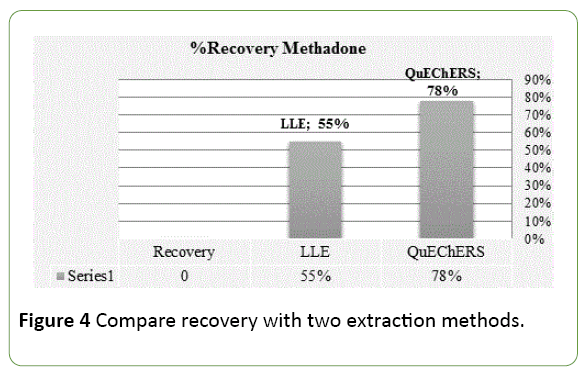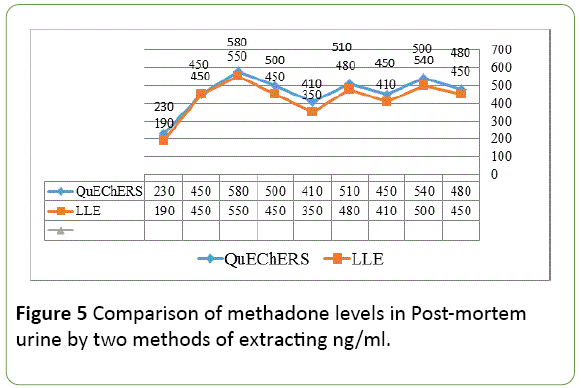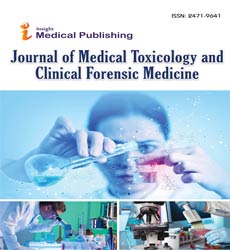Methadone Extraction by Modified Quechers and Liquid-Liquid Extraction from Post-Mortem Urine by GC-MS
Seyed Majid Salimi Asl, Mohammad Javad Khodayar, Zahra Mousavi and Maryam Akhgari
DOI10.21767/2471-9641.100030
1Department of Toxicology, Pharmaceutical Sciences Branch, Islamic Azad University, Tehran, Iran
2Department of Toxicology, School of Pharmacy, Ahvaz Jundishapur University of medical Sciences, Ahvaz, Iran
3Department of Pharmacology-Toxicology, Faculty of Pharmacy, Pharmaceutical Sciences Branch, Islamic Azad University, Tehran, Iran (IAUPS)
4Department of Forensic Toxicology, Legal Medicine Research Center, Legal Medicine Organization, Tehran, Iran
- Corresponding Author:
- Seyed Majid Salimi Asl
Department of Toxicology
Pharmaceutical Sciences Branch
Islamic Azad University, Tehran, Iran
Tel: 00989166172584
E-mail: majid.salimi2012@yahoo.com
Received date: November 06, 2017; Accepted date: December 04, 2017; Published date: December 11, 2017
Citation: Asl SMS, Khodayar MJ, Mousavi Z, Akhgari M (2017) Methadone Extraction by Modified Quechers and Liquid-Liquid Extraction from Post- Mortem Urine by GC-MS. J Med Toxicol Clin Forensic Med. Vol.3 No.2:10
Copyright: © 2017 Asl SMS, et al. This is an open-access article distributed under the terms of the Creative Commons Attribution License, which permits unrestricted use, distribution, and reproduction in any medium, provided the original author and source are credited
Abstract
Background: Methadone abuse in drug addiction centers and increased methadone consumption among addicts is a new cause of mortality due to substance abuse in forensic medicine. The usual method of extracting urine from corpses in most legal centers is a long and costly method of liquid-liquid extraction, which in addition to the high consumption of solvents and environmental contamination causes severe damage to the column of laboratory analysis devices. As a result, QuEChERS extraction method was proposed as an easy, fast, cheap and green way.
Keywords
LLE; QuEChERS; Methadone; Post-mortem urine; GC-MS
Introduction
QuEChERS stands for Quick, Easy, Cheap, Effective, Rugged and Safe. Alves et al. [1] first introduced this method to extract veterinary drugs from animal tissue. This method is widely used to determine pesticides [1]. In forensic medicine are usually use Liquid-Liquid extraction (LLE) and solid phase extraction (SPE) methods. The SPE method is expensive and the cleaning of the homogenizer probe creates a risk of contamination and crossreactivity, and therefore the SPE method is somewhat tedious and time-consuming and cannot be performed in many centers, but the QuEChERS method is widely used as a simple, fast and reliable method is used [2]. Extraction is an important step in the analysis of toxicology in forensic medicine [3,4]. Clinical toxicology and forensic medicine are heavily dependent on the science of decomposition chemistry [5,6]. Liquid-liquid extraction is simple but reduces its value due to inadequate extraction of samples and contamination of tools and the environment. The SPE method with a high selective performance, but this method is relatively costly and timeconsuming. The QuEChERS method was proposed for the analysis of legal toxicology [7]. The QuEChERS method is similar to LLE is simple and also similar to SPE have high selective performance [7,8]. The QuEChERS method is used to determine the residue of pesticides in food products [7,9]. QuEChERS is based on extraction with solvents such as acetonitrile or ethyl acetate and dehydration in the presence of salts such as magnesium sulfate and sodium chloride. Methadone is predominantly prescribed for treatment of heroin addiction and has a morphine-like function [10]. Some methadone is metabolized to the 2-Ethylidene-1,5-dimethyl-3,3- diphenylpyrrolidine (EDDP) by Cytochrome P450 (CYP3A4). The ratio EDDP to Methadone is used in the diagnosis of long-term and short-term treatment [11]. However, EDDP is the product of the side effect of high temperature GC on methadone. Reducing the temperature of the GC inlet port from 260 to 180°C reduced the concentration of EDDP observed in a methadone sample at an initial concentration of 10,000 ng/mL from 201 ng/mL to 53 ng/mL. As a result, alternative methods such as HPLC or LC-MS should be considered [12].
In this paper, Methadone extraction by QuEChERS from postmortem urine samples.
Materials and Method
The Methadone (ST) with concentration of 100 μg/mL (Sigmaal Rich), Methanol, Ammonia, Chloroform, Isopropanol, Acid hydrochloric acid, Ethyl acetate, Magnesium sulfate, Sodium hydrogen chloride (Figure 1).
The oven temperature increased from 60°C to 280°C at a temperature of 10°C and was kept constant at 280°C for 10 min.
Helium gas was used with a purity of 999/99 at a flow rate of 1 mL/min and a mass energy of 70 ev. Split less injection mode and run time is 30 min. The methadone identification method was based on the SIM index ion (Table 1).
| Analyte | Quantifier (m/z) | Qualifier(m/z) | RT |
|---|---|---|---|
| Methadoe | 72 | 294223165 | 11.7 |
| EDDP | 276 | 262220165 | 11.1 |
Table 1: Index ions in GC-MS.
For analysis of the Gas chromatography apparatus model 7890A connected to Agilent mass spectrometer Model 5975C equipped with a column (30 m*0.25 mm*0.25 μm thin film thickness), which used as a fixed phase with 5% phenyl methyl (Figure 2).
The results were analyzed with the Wiley7n.1 library software GC-MS according to the index (m/z) (Figure 3). Methadone validation and its results in Table 2.
| Accuracy | Precision | Quality control | LOQ | LOD | ||
|---|---|---|---|---|---|---|
| (%, n=3) | (%, n=3) | Concentration | (ng/mL) | (ng/mL) | N=3 | |
| (ng/mL) | ||||||
| 89 | 13.5 | 62.5 | Day=1 | |||
| 95 | 8 | 250 | 97.3 | 29.1 | Day=2 | Methadone |
| 101 | 11 | 2000 | Day=3 |
Table 2: methadone validation and its results.
Results
Methadone recovery rates in different samples in QuEChERS method were 65-78% (Figure 4). Generally, the rate of recovery in studies is between 80% and 120% (Figure 5). Jones et al. showed that for QuEChERS, 60-70% improvement for medium and non-polar compounds is acceptable [13].
Discussion
Extraction method in most of the forensic centers is LLE. Large volume of samples and solvents, inadequate extraction and contamination of tools and the environment are main disadvantages of LLE method [1]. Compounds of carcinogen and mutagen such as Chloroform and Ammonia, threat to the health of staff and experts in forensic centers. In addition, utilizing large amounts of solvent and chemicals seriously threatens the enviroment and human community. As a result, finding an efficient method with fewer risks force us to use new techniques such as SPE and QuEChERS.
QuEChERS was approved as a sensitive, renewable and relatively simple method for qualitative and quantitative analysis of drugs and medicine. Since this method does not require specific equipment and requires less time, this method has a great potential for analyzing clinical and legal samples.A review of the results from previous studies in QuEChERS extraction has proved its ability to detect drugs and drugs in biological samples. In a study by Emanuele Amorin Alves and colleagues in 2016 aimed at refining and developing the QuEChERS method, he was able to detect 13 opioid , methadone, and cocaine and their metabolites in total blood with the GC-MS device, Showed that this method has a high operational capability in various forensic cases [2]. It's easy to detect analyte with varying amounts of detection with a reagent and calculate the highest recovery, but the implementation of these methods is based on actual samples that are metabolized in the body or in samples of corpses that are corrupted after Death is different. There are numerous interventions in these samples, such as binding and conjugation of analyte to vital molecules, Postmortem Redistribution, metabolism, and the formation of secondary metabolites and post-mortem corruption makes it difficult to work. The results were much better in comparison with the LLE method in terms of ease, fastness and low cost.
Conclusion
The results of this study did not show significant difference betweenthe results of costly and time-consuming LLE method with QuEChERS method. Recovery of methadone in a much smaller volume of urine samples inQuEChERS, Showed that this method could replace LLE in detecting methadone in urine after death.
Financing and support
The cost of this thesis was completely personalized and with the scientific support of the Department of Toxicology, Faculty of Pharmacy, Jundishapur, Ahvaz, and the Legal Medicine Organization of Khuzestan-Ahvaz Province and the Toxicology Group of the Pharmaceutical Sciences University of Islamic Azad University, Tehran.
Acknowledgement
Thanks to all my dear professors and friends who helped me with this article.
References
- Alves EA, Agonia AS, Cravo SM, Afonso CM, Netto ADP, et al. (2017) GC-MS method for the analysis of thirteen opioids, cocaine and cocaethylene in whole blood based on a modified quechers extraction. Curr Pharm Anal 13: 215-223.
- Usui K, Hashiyada M, Hayashizaki Y, Yui I, Hosoya T, et al. (2014) Application of modified QuEChERS method to liver samples for forensic toxicological analysis. Forensic Toxicol 32:139-147.
- Bogusz MJ (2000) Liquid chromatography–mass spectrometry as a routine method in forensic sciences: A proof of maturity. J Chromatogr B Biomed Sci Appl 748: 3-19.
- Sauve E, Langødegård M, Ekeberg D, Øiestad AM (2012) Determination of benzodiazepines in ante-mortem and post-mortem whole blood by solid-supported liquid–liquid extraction and UPLC–MS/MS. J Chromatogr B Analyt Technol Biomed Life Sci 883: 177-188.
- Dinis-Oliveira RJ, Carvalho F, Duarte JA, Remião F, Marques A (2010) Collection of biological samples in forensic toxicology. Toxicol Mech Methods.20:363-414.
- Dinis-Oliveira RJ, Magalhães T (2013) Forensic toxicology in drug-facilitated sexual assault. Toxicol Mech Methods 23: 471-478.
- Anastassiades M, Lehotay SJ, Stajnbaher D, Schenck FJ (2003) Fast and easy multiresidue method employing acetonitrile extraction/partitioning and “dispersive solid-phase extraction” for the determination of pesticide residues in produce. J AOAC Int 86: 412-431.
- Payá P, Anastassiades M, Mack D, Sigalova I, Tasdelen B (2007) Analysis of pesticide residues using the Quick Easy Cheap Effective Rugged and Safe (QuEChERS) pesticide multi-residue method in combination with gas and liquid chromatography and tandem mass spectrometric detection. Anal Bioanal Chem 389: 1697-1714.
- Lehotay SJ, Son KA, Kwon H, Koesukwiwat U, Fu W (2010) Comparison of QuEChERS sample preparation methods for the analysis of pesticide residues in fruits and vegetables. J Chromatogr A 1217: 2548-2560.
- Soltaninejad K, Karimi M, Nateghi A, Daraei B (2016) Simultaneous determination of six benzodiazepines in spiked soft drinks by high performance liquid chromatography with ultra violet detection (HPLC-UV). Iran J Pharm Res 15: 457.
- Ferrari A, Coccia CP, Bertolini A, Sternieri E (2004) Methadone-metabolism, pharmacokinetics and interactions. Pharmacol Res 50: 551-559.
- George S, Braithwaite RA (1999) A pilot study to determine the usefulness of the urinary excretion of methadone and its primary metabolite (EDDP) as potential markers of compliance in methadone detoxification programs. J Anal Toxicol 23: 81-85.
- Jones AW1, Holmgren A, Kugelberg FC (2008) Driving under the influence of opiates: concentration relationships between morphine, codeine, 6-acetyl morphine and ethyl morphine in blood. J Anal Toxicol 32: 265-272.

Open Access Journals
- Aquaculture & Veterinary Science
- Chemistry & Chemical Sciences
- Clinical Sciences
- Engineering
- General Science
- Genetics & Molecular Biology
- Health Care & Nursing
- Immunology & Microbiology
- Materials Science
- Mathematics & Physics
- Medical Sciences
- Neurology & Psychiatry
- Oncology & Cancer Science
- Pharmaceutical Sciences





